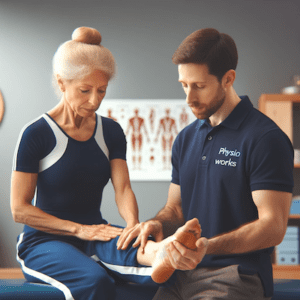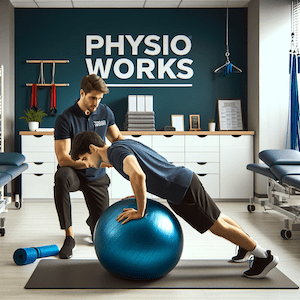Manual Physiotherapy Techniques
Article by John Miller

Manual Physiotherapy Techniques for Joint Treatment
Understanding Joint Issues: Pain, Stiffness, and Hypermobility
Joints are vital for movement and daily functioning. Problems like pain, stiffness, and hypermobility can arise due to various factors, such as injuries or age-related wear and tear. These symptoms may occur alone or together, leading to discomfort and reduced mobility.
Manual Physiotherapy Techniques
Empowering Movement and Alleviating Discomfort
Physiotherapy plays a crucial role in restoring joint function. A skilled physiotherapist can assess your joints, pinpoint issues, and design a treatment plan. They consider factors like painful movement, stiffness, and hypermobility. Customised treatment helps regain full range and pain-free motion.
Recent Advances in Joint Mobilisation
Innovations for Gentle and Effective Treatment
Recent developments have revolutionised joint mobilisation techniques. Now, treatment focuses on gentle, non-invasive methods rather than forceful adjustments. This approach enhances safety and comfort, offering relief without causing additional stress to the joints.
Why Do Joints Suffer?
The Mechanics Behind Joint Discomfort
Joints can stiffen or lock due to injuries affecting muscles, tendons, and ligaments. Misalignment or control issues often lead to unnatural joint movements, causing pain and stiffness. A physiotherapist’s assessment is crucial in diagnosing and treating these issues effectively.
The Role of Physiotherapeutic Joint Treatment
A Holistic Approach to Joint Health
Physiotherapists employ a variety of techniques for joint mobilisation and pain relief. These may include:
- Gentle mobilisations like Maitland, Mulligan, and Kaltenborn techniques.
- Mobility exercises such as McKenzie exercises.
- Minimal energy techniques for active joint repositioning.
- Joint manipulation for locked joints.
- Traction and distraction methods.
- Physiotherapy Instrument Mobilisation (PIM).
These techniques, combined with an individualised treatment plan, can significantly improve joint function and alleviate discomfort.
The Future of Musculoskeletal Physiotherapy
Embracing Technology and Research
Recent research in musculoskeletal physiotherapy has emphasised the importance of evidence-based practice. Advanced imaging techniques and biomechanical studies are now integral to understanding joint issues. This knowledge has led to more precise and effective treatment methods.
Conclusion: Seeking Professional Advice
Your Path to Improved Joint Health
Joint issues can significantly impact your quality of life. However, with the advancements in manual physiotherapy techniques and a deeper understanding of musculoskeletal health, effective relief is within reach.
Consulting a professional physiotherapist is a crucial step in addressing your joint concerns. They can provide a comprehensive assessment and a tailored treatment plan to suit your specific needs.
Don’t let joint pain and stiffness hold you back – seek the knowledge of a physiotherapist and embark on your journey to better joint health and improved mobility.
Maximising Your Health with Physiotherapy Treatment
Exploring Physiotherapy Treatment for Pain and Injury
Physiotherapy treatment shines as a beacon of hope for individuals grappling with illnesses, injuries, or disabilities. Physiotherapists proactively utilise an array of techniques, including exercises, manual therapies, and soft tissue manipulation. Their professional skills extends to educating patients on managing pain, facilitating injury recovery, and retaining autonomy in daily functions.


Acute and Sub-Acute Injury Management
Physiotherapy treatment strategies are meticulously designed to address both acute and sub-acute injuries. With a focus on joint mobilisation, manipulation, and targeted soft tissue work, physiotherapists ensure each patient embarks on an efficient path to recovery. Supportive devices such as strapping, taping, and braces often complement these techniques.
Incorporating Alternative Therapies
In their holistic approach, many physiotherapists incorporate alternative methods like acupuncture and dry needling to augment pain relief and muscle function. Tailored physiotherapy exercises, ranging from stretching to Swiss ball workouts, are prescribed to meet the diverse needs of patients.
Specialised Physiotherapy Treatment
Specialised services within physiotherapy cater to specific groups and needs. Sports physiotherapy, women's and men's health, and workplace physiotherapy are distinct areas that address the particular challenges faced by different patient populations. Electrotherapy and local modalities such as therapeutic ultrasound and TENS machines represent the another side of physiotherapy treatments.
Targeted Physiotherapy Treatment for Injury Recovery
For those facing acute or sub-acute injuries, physiotherapists provide immediate and effective treatments that target pain, swelling, and inflammation. They blend traditional methods with innovative techniques to foster healing and functional restoration.
Hands-On Techniques in Physiotherapy
The hands-on aspect of physiotherapy is fundamental, with practitioners employing joint mobilisation, manipulation, and massage to catalyse healing and reduce discomfort. Ongoing learning and collaboration with other health professionals ensure that physiotherapy care is both comprehensive and customised.
Support Through Taping and Bracing
Physiotherapists are adept at applying various taping methods and supportive braces to aid in the stabilisation and rehabilitation process. They assess and determine the most suitable support mechanisms for each individual's condition.


Exercise Prescription for Rehabilitation
A broad spectrum of exercises is at the heart of physiotherapy treatment plans. From enhancing muscle flexibility to improving balance and proprioception, physiotherapists deliver evidence-based exercise regimens aimed at optimising recovery and function.
Biomechanical Analysis for Customised Care
A thorough biomechanical assessment underpins the physiotherapeutic approach, guiding the development of personalised treatment plans. This detailed analysis ensures that interventions are accurately targeted to address specific issues.
Specialised Physiotherapy Treatment Modalities
Hydrotherapy and sports physiotherapy offer targeted treatment options for individuals with specific needs, from aquatic exercises to specialised programs for athletes. Vestibular physiotherapy is dedicated to resolving balance disorders and associated symptoms.
Gender-Specific and Workplace Physiotherapy
Addressing the unique health concerns of both men and women, gender-specific physiotherapy utilises techniques like pelvic floor exercises. In the workplace, physiotherapy focuses on preventing and managing job-related injuries, contributing to a healthier work environment.
Conclusion: The Journey to Wellness with Physiotherapy
In conclusion, physiotherapy treatment is a richly diverse field, providing individualised care and a broad range of techniques to support patients on their path to recovery. It's essential to engage with a professional physiotherapy team to develop a tailored approach for achieving personal health and wellness objectives.
Related Articles
- Manual Physiotherapy Techniques: Focusing on joint mobilisation, manipulation, and soft tissue work, this article is ideal for readers seeking to understand the hands-on aspect of physiotherapy.
- Physio Instrument Mobilisation (PIM): This article covers the use of instrument-assisted mobilisation in physiotherapy, providing insights into how these tools aid in treatment.
- Essential Guide To Muscle Treatment: It gives an overview of muscle treatment practices in physiotherapy, including rest, ice, and heat therapies. It's helpful for readers wanting to know about muscle recovery.
- Dry Needling - An Effective Physio Treatment Explained: This article dives into the benefits and applications of dry needling in rehabilitation, discussing its effectiveness in pain management, improving joint mobility, and releasing myofascial trigger points.
- Physiotherapy & Exercise Prescription: It highlights the importance of tailored exercise regimens in physiotherapy, discussing how physiotherapists use their knowledge of exercise physiology to craft personalised treatment plans.
- Acute Injury Treatment - Soft Tissue Recovery Tips: This article offers tips and strategies for the recovery of soft tissue injuries, focusing on the role of physiotherapy in the healing process.
- Electrotherapy & Local Modalities: This piece explores physiotherapy treatment modalities like ultrasound and tens machines, and their role in treating pain disorders.



